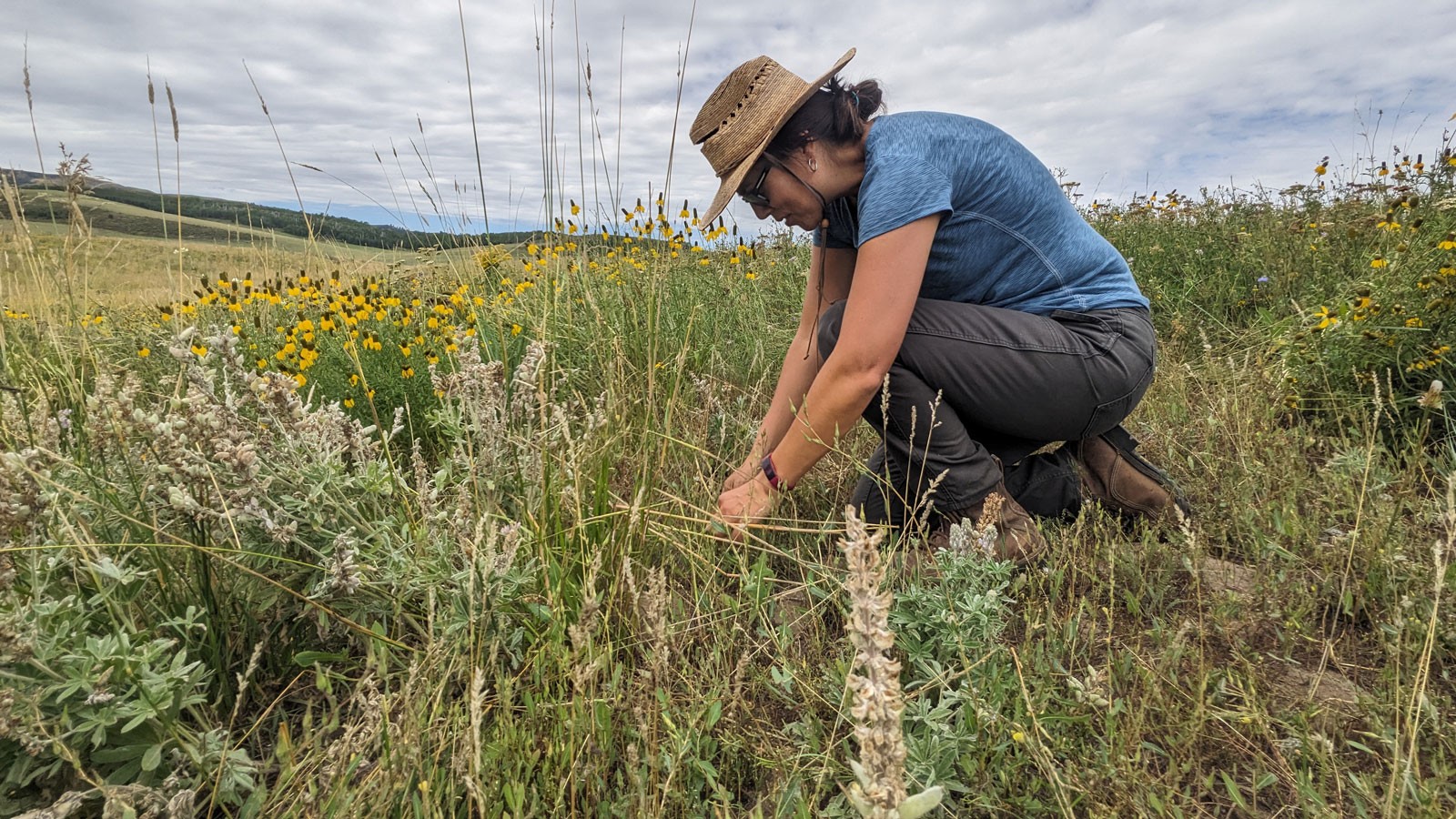New Research Tracks Successes for Transplanting Full-Sized Mountain Big Sagebrush
By Lael Gilbert |
Researcher Kari Veblen evaluates vegetation growing inside a restoration area at Fox Hills Ranch, where the team is finding that transplanting mature, local sagebrush, though more expensive, may have better chances at survival than seeds or seedlings. (Photo Credit: USU/Lael Gilbert)
Blistering summers and snow-piled winters are the exacting norm on the high deserts of the West, so you’d expect the area’s iconic and hardy sagebrush to multiply like rabbits. But ask anyone who’s attempted to grow sagebrush from seed on a landscape blackened by wildfire, impacted by mining or invaded by non-native grasses, they’ll tell you how maddeningly finicky that task can be.
Recent research from a team from the Quinney College of Natural Resources, in collaboration with the Bayer Corporation, has begun to tease out strategies for better sagebrush rehabilitation — but it has required out-of-the-box thinking.
Perhaps in a fit of justified frustration, managers are increasingly using greenhouse-grown sagebrush seedlings for range rehabilitation in the Western U.S. — but these sorts of transplant efforts can have unreliable results, even with the added expense of feet on the ground to shoehorn the young plants into the soil. So when managers at Bayer’s Soda Springs Idaho Site, which includes a 2,400-acre working ranch (Fox Hills Ranch) had a bit of an outlandish idea, Eric Thacker and Kari Veblen from USU’s Department of Wildland Resources were up for exploration.
Worldwide, 10-20% of dryland ecosystems are now considered severely degraded, making it imperative to find ways to rebuild these complex and slow-growing plant communities. Sagebrush is a foundational species. It provides cover and food for a variety of native birds, animals and insects.
But tiny, ephemeral sagebrush seeds don’t disperse long distances on their own and don’t stay viable for long on the ground. When disturbance removes mature plants from large tracts of land, reestablishing them requires a live, local source for seeds. Scattering even hundreds of thousands of sagebrush seeds over multiple seasons often results in only a few isolated plants establishing well enough to produce seed on their own. This leaves vast, vulnerable gaps, where invasive weeds can make themselves at home and plunder available resources.
What if, Bayer Environmental-Reclamation Specialist Joe Via wondered, they tried transplanting full-sized wild sagebrush into degraded areas — just like you would a rosebush or a peach tree in a garden — to act as a seed source? Via identified a tract of land where the company’s mining activities were set to expand, and offered the existing mountain big sagebrush plants (which would have to be removed anyway) for the transplant experiment on a stretch of land slated for restoration at Fox Hills Ranch.
This approach was breaking new ground for sagebrush restoration, said Liz Bailey, the USU master’s student who took on the brunt of the work for the project. It would, the team knew, be incredibly effort-intensive to dig up mature sagebrush plants and relocate them to a new area. They also recognized that the effort would certainly be expensive compared to seeds or sagebrush seedlings — but considering the miserable rates of successful establishment typically recorded for these other projects, the costs could still prove to be reasonable, especially when counting surviving, established plants as the success metric, rather than just acres attempted.
After clearing non-native vegetation from the experimental area and seeding the area with a diversity of plant species, the team planted sagebrush three ways for comparison — from seed, from greenhouse seedlings, and by transplanting wild sagebrush plants — and tracked survival rates of each strategy over several years. After the third year, the greenhouse-grown plants had a survival rate of just 14%, while 85% of the transplanted sagebrush survived.
Although other studies have shown better success using greenhouse-grown plants, success rates tend to vary wildly depending on local circumstances, Bailey said, which is part of the problem.
“This really showed that wild, established plants transplanted with an intact root ball can be used to get high rates of early establishment for mountain big sagebrush,” Bailey said. “Although there is still a chance that the tap root might be severed when digging up mature plants for transplant, the remaining roots can keep contact with the soil and keep the plants alive.”
Harvesting the wild plants close to the project site (from approximately 7 miles away) probably contributed to the high survival rates, she said. Local plants have the chance to develop local adaptations — such as higher drought and frost resistance, customized growth rates and other competitive advantages over seeds from outside that aren’t locally-adapted.
The cost per surviving plant also leaned in favor of a transplanting strategy, despite the increased effort required, coming in at around half the price of seedlings ($3.68 for each surviving mature wild plant versus $7.95 for each surviving greenhouse seedling).
The team is now tracking how these plants expand their territory — whether mature sagebrush plants will continue to act as productive seed sources after being translocated, and if these new plants survive and thrive.
Bayer has shared information and progress with federal and state agencies, other local management agencies, holding field excursions to let others see the successes and challenges on the project. Ongoing monitoring would allow the team to understand the long-term trajectory of the ecosystem in this slow-growing environment, and they’ll take every year they can get to watch where the sagebrush grows.
WRITER
Lael Gilbert
Public Relations Specialist
Quinney College of Natural Resources
435-797-8455
lael.gilbert@usu.edu
CONTACT
Eric Thacker
Assistant Professor
Department of Wildland Resources
435-797-7874
eric.thacker@usu.edu
TOPICS
Environment 287stories Ecology 178stories Business 165stories Conservation 87storiesComments and questions regarding this article may be directed to the contact person listed on this page.







